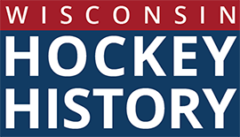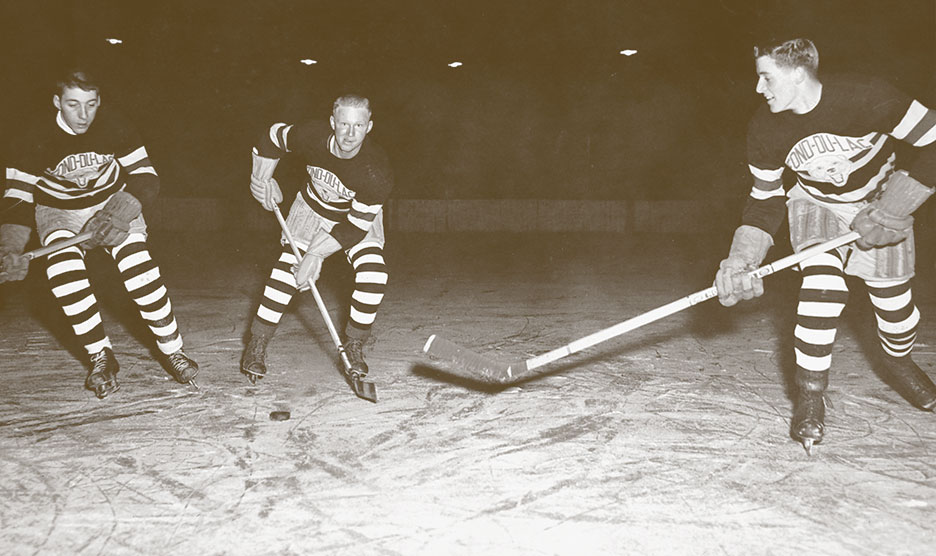Unseasonably warm, rainy weather has forced the closing of the indoor rink at the Fond du Lac County Fairgrounds until further notice. Several youth games scheduled for today were cancelled as well as public skating for the weekend.” This news item appeared in the December 30, 1972 issue of the Fond du Lac Reporter. Fortunately, for the skaters of Fond du Lac, plans were already underway to install artificial ice in the Fairgrounds’ Recreation Building. By December of the next year, the system had been installed.
Hockey in Fond du Lac as an organized sport had its beginnings in the late 1920s. By 1934, Obie Hoffman began the Bears senior men’s team. The development of the Bears hockey team is closely connected to the successful operation of the Blue Line Club, the sponsors of the current Fond du Lac hockey program.
Obie Hoffman coached and managed the Bears from 1934–1946. The Bears competed in the Wisconsin State Hockey League and skated on one of two outdoor rinks located near Goodrich High School. During this time, the city boasted one of the finest youth hockey programs in the country with over 400 youth participating. Two of these skaters, Joe Lotzer and Wayne McKibbon played college hockey at the University of Illinois. Joe’s brothers Bill and Bob also played college hockey at Marquette and Michigan, respectively.
From 1946–1949, Howie Farrey managed the Bears. In 1948, a 14-year-old youngster named Don Kohlman played his first game for the Bears. Farrey left Fond du Lac to enter the insurance business in Sheboygan, but Kohlman was just beginning his long association with the Bears. Nearly twenty-five years later ,Kohlman and Farrey teamed up to improve Fond du Lac’s hockey program.
In 1956, Kohlman became general manager of the Bears. Kohlman’s goaltender was a young man named Bob Bentley. Kohlman and Bentley eventually became involved in the development of youth hockey programs in the neighboring communities of Fond du Lac and Waupun.
The Bears and youth hockey, sponsored by the recreation department, during the 1950s and early 60s, continued to skate on the outdoor rink at the high school. During this time, the Bears attracted some hearty supporters. Joe Goeser of radio station KFIZ recalls one state tournament in which the warmest day was -18 degrees. “Fans would stand atop the snow banks, sip some refreshments for warmth, and rush to the Lakeside Tavern for hot chili after the game.”
When Kohlman learned of a proposed new building at the Fairgrounds, he along with Tom Nelson, approached the County Board. They were able to convince the Board to build a clear span structure large enough (100×200 feet) to house an ice rink. The county building was constructed during the fall and winter of 1965–66. The Fond du Lac Bears and youth hockey went indoors for the 1966–67 season. One of the first games in the new building was a University of Wisconsin intra-squad game. Tom Nelson’s son Greg, a product of the Fond du Lac youth program, skated in that game and eventually lettered three years for the Badgers.
During those years, the Bears became more involved with youth hockey. “Tom Nelson and I would haul ’em all over the state and I didn’t even have a kid playing yet,” Kohlman reminisces. The youth program in 1969–70 involved 50 skaters. Within two years, the number increased to 150. By the early 70s, the Bears program, youth hockey, and operating the rink had developed into a time-consuming activity. A number of Bears supporters and friends of Kohlman organized the Blue Line Club to sponsor youth hockey. At the first meeting in September, 1971, ten members joined together, chipped in $20 each, and set a lofty goal of artificial ice for the Fairgrounds. Within two years, the Club accomplished this goal.
But the task wasn’t that easy, recalls Emmett Leonhardt, current president of the Blue Line Club. “One of our first fundraisers was setting up a concession for the volunteer firemen at a practice house burning. We netted $2.00 on that project.”
The projected cost for installing artificial ice was $70,000. This would include the cost of the chiller (refrigeration unit), a condenser, plastic piping, a concrete floor, a concrete block building for housing the refrigeration equipment, and two locker rooms..
The fundraising drive began in the spring of 1972. The project included three phases. Phase one involved contacting hockey families and supporters for donations. This eventually raised about $12,000. Phase two was to contact businesses and professionals in the community for their support. Phase three sought the support of local unions and tradesmen.
From 1971–73, the Blue Line Club expanded and became quite active. The Club sponsored youth hockey, high school hockey, the Bears, operated the rink and promoted hockey throughout the community. The success of the initial fundraising encouraged the Club to begin Phase two. As if by destiny, Howie Farrey returned to Fond du Lac after retiring from the insurance business. Howie volunteered to become the Club’s fundraising coordinator. He approached businesses and individuals in the community who had little or no interest or involvement in hockey. “He was a big factor,” Jerry Tighe recalls. He spread the word about the Blue Line Club. More than once, he would come to a meeting with a “few checks for you.” These checks often would total $4000–$5000. The community became involved in the project. Radio station KFIZ sponsored a Brewer night with proceeds to the Blue Line Club. The Rotary chipped in $2500. Other service clubs and businesses donated.
The Club arranged a community service loan through the First Wisconsin Bank. Twenty-six couples guaranteed the loan. Connie Fritz chuckles when he recalls, “At the time no one realized that if anyone dropped out, the rest were liable for the entire sum, not just their share.”
By April 1973, the materials for installing artificial ice were ordered. During the summer of 1973, club members worked weekends and nights to complete the project. Kohlman mentions that members gave up one summer of their life for the artificial ice.
The project involved laying some twenty miles of plastic piping, doing preparation work for the concrete floor, building a 37×75 foot concrete building to house the refrigeration unit, and two locker rooms. All the labor except the concrete work was donated. (Smith Construction of Fond du Lac poured the concrete floor.) Club members and local trade unions contributed 4000–5000 man-hours to complete the project.
The project itself was designed piece meal. “We felt a packaged system was too expensive, so we designed our own,” says Paul Masini. “We purchased the refrigeration locally from Hansen Refrigeration. We didn’t know anything about artificial ice. We put it together and it worked!” laughs Masini. Masini’s engineering degree from Michigan Tech was no doubt quite helpful.
On schedule, the members of the Fond du Lac Blue Line Club skated on artificial ice November 1, 1973. The total cost of the project was $65,000. With the donated materials and labor, the estimated value of the project reached $200,000. The entire community of Fond du Lac can take pride in the accomplishments of the Blue Line Club. A large portion of the community contributed to these accomplishments.
Prior to 1973, the indoor ice season averaged six weeks in length from late December to early February. From 1966–1973, Fond du Lac youth hockey teams won one state championship. That championship team, coached by Bill Ward and Bob Bentley, consisted of half Waupun and half Fond du Lac players. They won the state Pee Wee B title in Wausau. Meanwhile, the Bears fared much better winning state titles in 1970 and 1972 and placing second in 1971. The 1970 championship was the first in the 36 years existence of the Bears. During the successful years of the early seventies, to the chagrin of local boosters, the Bears roster included a majority of out-of-town players.
Since the installation of artificial ice, the Fond du Lac program has won seven state championships: Mite A in 1975, Squirt A in 1976, Pee Wee AA and B in 1978, and Bantam AA and B in 1980, and the Bears in 1978. The Fond du Lac youth hockey program has become one of the powers in the state.
The numbers of participants increased from about 100 in the early 1970s to 450 (including 100 girls) in 1975, but leveled off to 300 in 1980. The annual budget to operate the program is $70,000. This money pays for the operation of the building, running the youth hockey program and the Bears, the concession stand, and a monthly note payment. The only paid help is a small janitorial staff and referees for the hockey games.
Since 1973, the Club has continued to make improvements in the rink. Gas radiant heat was added to the bleacher area. A new lobby and permanent concession stand were added in 1975. Plexiglass and rubber matting also were added. New lighting and a new scoreboard came in 1980.
With the reality of artificial ice, the Blue Line Club has been able to develop a successful program that has become well accepted in the community. But, the Club is not without its shortcomings. Many people complain that the rink (75”x175’) is too small. Don Kohlman says of the rink, “It’s ours, it’s paid for and the kids pay nothing for the opportunity.” Nevertheless, the Club is seriously considering deepening the corners for next year.
Update–The above article was originally written in 1980 and appeared in the first issue of Hockey Exchange April 1980.
In the fall of 1980, Fond du Lac St. Mary’s Springs High School began a varsity hockey program under the tutelage of Jerry Tighe. That team won four state private school titles in the 1980s and finished second twice. Coach Tighe was inducted into the Wisconsin High School Coaches Hockey Hall of Fame in 2014.
A rink expansion to the Fairgrounds building did occur in the 1980s. By the 1990s, the Fond du Lac hockey program had expanded. Fond du Lac High School and Marian University added hockey and a second ice sheet was necessary. In 1996, a new million-dollar arena was built on the Fairgrounds property. Later, a second rink was added and the original Fairgrounds facility closed in the early 2000s.
Howie Farrey and Don Kohlman, both pioneers of Fond du Lac hockey, were inducted into the Wisconsin Hockey Hall of Fame in 1976 and 1977, respectively.
Fond du Lac High School appeared in five WIAA state championship games winning their lone title in 2007. The Fond du Lac girls’ co-op team has also appeared in five state championships. The WarBirds won titles in 2004 and 2006.

